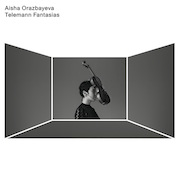In my first composition class as an undergrad at Goldsmiths College in the early noughties, we listened to Xenakis’ Kottos for solo cello. Coming from a very conventional musical background, it was a serious ear-opening; nine minutes of swooping, grinding harmonic tremolo-ing extended techniques. I was shocked, appalled, curious, intrigued and, finally, captivated.
Was this music? These ugly, disturbing, compelling sounds? Was this discomfort and fascination how music was supposed to make me feel? I began to explore. The greats of 20th-century avant-garde music – Cage, Varese, Berio, Ligeti, George Crumb – became my Elvis Presley, my Sex Pistols. This was music which moved – that spoke to me.
I tell you this story because this album of Telemann by Aisha Orazbayeva does not recall that feeling.
A Londoner originating from Kazakhstan, Violinist Orazbayeva is no stranger to the experimental: this is the second of her releases on PRAH records, after 2014’s The Hand Gallery, which featured music by Steve Reich and Morton Feldman as well as her own works. She also has a seriously impressive previous release – Outside, on Nonclassical – in her own back catalogue.
For this new album, Orazbayeva brings some of the techniques of the experimental world to the very different genre of baroque solo violin, tackling six of Telemann’s 12 Fantasias for solo violin.
After an introductory three-minute first track, an almost silent streetscape, comes the first of the Fantasias – the B-flat major. Much of this is played with the bow dragged lightly across the strings, giving a scratchy, insubstantial sound, whistling as they squeak. There are some interesting sounds and colours, and the close recording style captures everything beautifully, including the sections that are played full voice.
This sets the pattern for the whole album: there are sections of ‘conventional’ playing, but much of the music is delivered through extended techniques, exploring the sounds locked in the instrument’s materials.
After broadening into a warmer sound in the middle, the track two B-flat major peters out into the whispered ether; the closing section of track three is delivered in an aggressive, pizzicato, allowing the whole violin to ring out the vibrations caused. The third movement of track five has a particularly interesting metallic tone sometimes recalling a distorted electric guitar.
But the long-bowed, open playing of the first movement, of the gorgeous F minor Fantasia which comes next, is a contrast and – frankly – a relief. This is committed playing, with a sense of pathos, of phrase shape, of pacing; all rather missing elsewhere on the album.
I do get what Orazbayeva is trying to do – to get beyond the conventional hearing and see what else is there. But I’m afraid the parts of this album I most enjoyed were the more conventional moments. Her mastery of extended techniques is undoubted – her 2011 recording of the Sciarrino Six Caprices is magnificent – but the baroque solo repertoire is just not the material with which to display it. Unusually for Orazbayeva there is something workaday and unemotional about the playing and it really fails to move.
The musicality Orazbayeva displays in exploring and reimagining is considerable, but this also makes her straight playing of these beautiful pieces compelling enough. The sounds that she makes are undoubtedly intriguing, but I just can’t hear the music through them.


